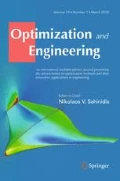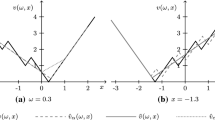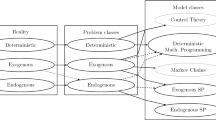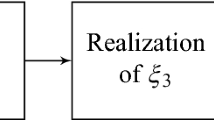Abstract
In this paper, we focus on multiobjective two-level simple recourse programming problems, in which multiple objective functions are involved in each level, shortages and excesses arising from the violation of the constraints with discrete random variables are penalized, and the sum of the objective function and the expectation of the amount of the penalties is minimized. To deal with such problems, a concept of Pareto Stackelberg solutions based on the reference objective levels is introduced. Using the Kuhn–Tucker approach in two-level programming, we formulate as a mixed integer programming problem, and propose an interactive algorithm to obtain a satisfactory solution of the leader from among a Pareto Stackelberg solution set based on the reference objective levels. A numerical example illustrates the proposed algorithm for a multiobjective two-level stochastic programming problem with simple recourses under the hypothetical leader.



Similar content being viewed by others
Notes
Numerical Optimizer, NTT DATA Mathematical Systems Inc., https://www.msi.co.jp/nuopt/.
References
Abdelaziz FB (2012) Solution approaches for the multiobjective stochastic programming. Eur J Oper Res 216:1–16
Ahmad YA, Haneefa K (2019) Bi-level multi-objective stochastic linear fractional programming with general form of distribution. Stat Optim Inf Comput 7:407–416
Bard JF (1991) Some properties of the bilevel programming problem. J Optim Theory Appl 68:371–378
Bialas WF, Karwan MH (1984) Two-level linear programming. Manag Sci 30:1004–1020
Birge JR, Louveaux F (1997) Introduction to stochastic programming. Springer, Berlin
Charnes A, Cooper WW (1959) Chance constrained programming. Manag Sci 6:73–79
Danzig GB (1955) Linear programming under uncertainty. Manag Sci 1:197–206
Dempe S (2002) Foundations of bilevel programming. Kluwer Academic Publishers, Berlin
Dempe S, Kalashnikov VV, Perez-Valdes GA, Kalashnykova NI (2011) Natural gas bilevel cash-out problem: convergence of a penalty function method. Eur J Oper Res 215:532–538
Dempe S, Kalashnikov V, Perez-Valdes GA, Kalashnykova N (2015) Bilevel programming problems: theory, algorithms and applications to energy networks. Springer, Berlin
Emam OE (2013) Interactive approach to bi-level integer multi-objective fractional programming problem. Appl Math Comput 223:17–24
Fang S, Guo P, Li M, Zhang L (2013) Bilevel multiobjective programming applied to water resources allocation. Math Probl Eng. Article ID 837919:
Fliege J, Vicente LN (2006) Multicriteria approach to bilevel optimization. J Optim Theory Appl 131:209–225
Fortuny-Amat J, McCarl B (1981) A representation and economic interpretation of a two-level programming problem. J Oper Res Soc 32:783–792
Gutjahr WJ, Pichler A (2016) Stochastic multi-objective optimization: a survey on non-scalarizing methods. Ann Oper Res 236:475–499
Jeroslow RG (1985) The polynomial hierarchy and a simple model for competitive analysis. Math Program 32:146–164
Júdice JJ, Faustino AM (1992) A sequential LCP method for bilevel linear programming. Ann Oper Res 34:89–106
Kalashnikov V, Perez-Valdes GA, Kalashnykova NI (2010a) A linearization approach to solve the natural gas cash-out bilevel problem. Ann Oper Res 181:423–442
Kalashnikov V, Perez-Valdes GA, Tomasgard A, Kalashnykova NI (2010b) Natural gas cash-out problem: bilevel stochastic optimization approach. Eur J Oper Res 206:18–33
Kalashnikov V, Dempe S, Perez-Valdes GA, Kalashnykova NI, Camacho-Vallejo JF (2015) Bilevel programming and applications. Mathe Probl Eng. Article ID 310301
Kall P, Mayer J (2005) Stochastic linear programming models, theory, and computation. Springer, Berlin
Karimi H, Ekşioğlu SD, Carbajales-Dale M (2019) A biobjective chance constrained optimizationmodel to evaluate the economic and environmental impacts of biopower supply chains. Ann Oper Res (online)
Katagiri H, Nishizaki I, Sakawa M, Kato K (2007) Stackelberg solutions to stochastic two-level linear programming problems. In: First IEEE symposium on computational intelligence in multi-criteria decision-making, Hawaii
Lachhwani K, Dwivedi A (2018) Bi-level and multi-level programming problems: taxonomy of literature review and research issues. Arch Comput Methods Eng 25:847–877
Li M, Fu Q, Singh VP, Liu D, Li T (2019) Stochastic multi-objective modeling for optimization of water–food–energy nexus of irrigated agriculture. Adv Water Resour 127:209–224
Lu HW, Huang GH, Zeng GM, Maqsood I, He L (2008) An inexact two-stage fuzzy-stochastic programming model for water resources management. Water Resour Manag 22:991–1016
Nishizaki I, Sakawa M (1999) Stackelberg solutions to multiobjective two-level linear programming problems. J Optim Theory Appl 103:161–182
Nishizaki I, Sakawa M, Katagiri H (2003) Stackelberg solutions to multiobjective two-level linear programming problems with random variable coefficients. CEJOR 11:281–296
Rahmanniyay F, Yu AJ, Seif J (2019) A multi-objective multi-stage stochastic model for project team formation under uncertainty in time requirements. Comput Ind Eng 132:153–165
Ruuska S, Miettinen K, Wiecek MM (2012) Connections between single-level and bilevel multiobjective optimization. J Optim Theory Appl 153(153):60–74
Sakawa M (1993) Fuzzy sets and interactive multiobjective optimization. Plenum Press, New York
Sakawa M, Kato K (2009) Fuzzy random noncooperative two-level linear programming through absolute deviation minimization using possibility and necessity. Interim report, IR-09-021, International Institute for Applied Systems Analysis (IIASA)
Sakawa M, Matsui T (2014) Interactive fuzzy multiobjective stochastic programming with simple recourse. Int J Multicriteria Decis Mak 4:31–46
Sakawa M, Nishizaki I (2009) Cooperative and noncooperative multi-level programming. Springer, Berlin
Sakawa M, Nishizaki I, Katagiri H (2011) Fuzzy stochastic multiobjective programming. Springer, Berlin
Sakawa M, Yano H, Nishizaki I (2013) Linear and multiobjective programming with fuzzy stochastic Extensions. Springer, Berlin
Sakawa M, Katagiri H, Matsui T (2014) Interactive fuzzy stochastic two-level linear programming with simple recourse. Inf Sci 278:67–75
Sekizaki S, Nishizaki I, Hayashida T (2016) Electricity retail market model with flexible price settings and elastic price-based demand responses by consumers in distribution network. Int J Electr Power Energy Syst 81:371–386
Uno T, Katagiri H, Kato K (2007) An application of particle swarm optimization to bilevel facility location problems with quality of facilities. Asia Pac Manag Rev 12:183–189
Walkup DW, Wets R (1967) Stochastic programs with recourse. SIAM J Appl Math 15:139–162
Wets R (1974) Stochastic programs with fixed recourse: the equivalent deterministic program. SIAM Rev 16:309–339
White DJ, Anandalingam G (1993) A penalty function approach for solving bi-level linear programs. J Glob Optim 3:397–419
Wierzbicki AP (1980) The use of reference objectives in multiobjective optimization. In: Fandel G, Gal T (eds) Multiple criteria decision making; theory and applications. Lecture notes in economics and mathematical systems, vol 177. Springer, Berlin, pp 468–486
Zhang G, Lu J (2010) Fuzzy bilevel programming with multiple objectives and cooperative multiple followers. J Glob Optim 47:403–419
Zhang F, Yue Q, Engel BA, Guo S, Guo P, Li X (2019) A bi-level multiobjective stochastic approach for supporting environment-friendly agricultural planting strategy formulation. Sci Total Environ 693:1–14. https://doi.org/10.1016/j.scitotenv.133593
Author information
Authors and Affiliations
Corresponding author
Additional information
Publisher's Note
Springer Nature remains neutral with regard to jurisdictional claims in published maps and institutional affiliations.
Rights and permissions
About this article
Cite this article
Yano, H., Nishizaki, I. Multiobjective two-level simple recourse programming problems with discrete random variables. Optim Eng 22, 1181–1202 (2021). https://doi.org/10.1007/s11081-020-09532-9
Received:
Revised:
Accepted:
Published:
Issue Date:
DOI: https://doi.org/10.1007/s11081-020-09532-9




